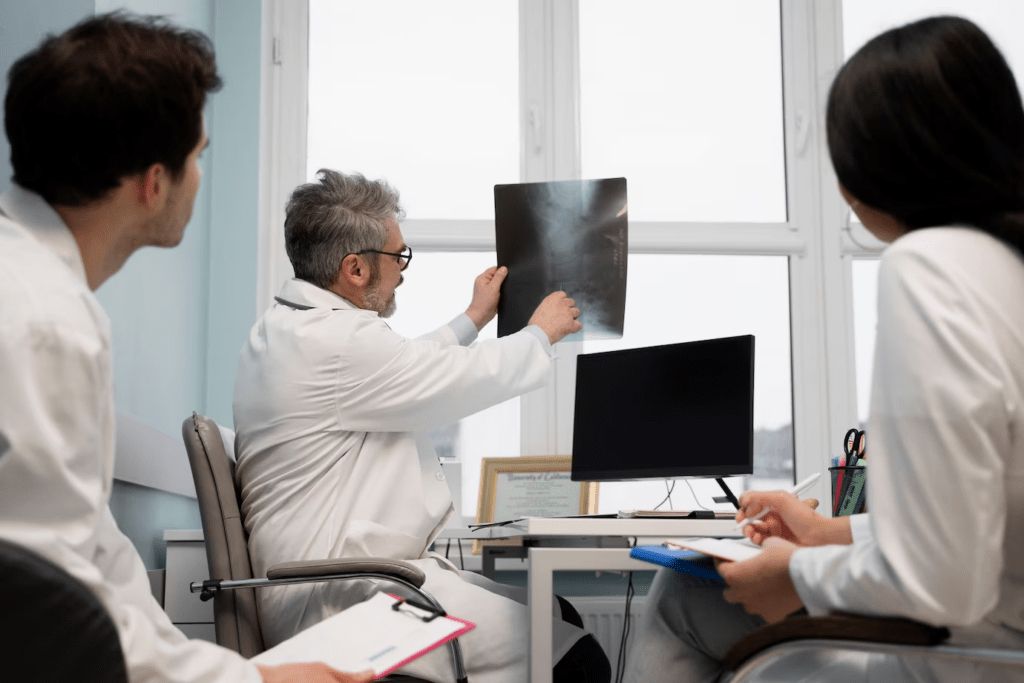
Radiologic technology is a fast-growing field with many job opportunities. According to U.S. News and World Report, radiology techs are ranked #17 in the best healthcare support jobs.
Radiology technicians perform important scans and imaging tests to help doctors understand patients’ health.
If you’re looking for the fastest way to become a radiology tech, learning about the requirements can help you succeed.
Let’s learn what a radiology technician does, how to become one, the skills you may need, and answer common questions about the job.
What is a Radiology Technician?
Radiology is a medical field that uses imaging tools to diagnose diseases and plan treatments for patients. A radiology technician is a healthcare worker who performs these imaging procedures.
Radiology techs, also known as radiologic technicians or radiographers, help position patients for imaging, work with other healthcare professionals, and explain the process to patients.
Some of the equipment they use includes:
- Ultrasound
- X-ray
- CT (Computed Tomography) scans
- MRI (Magnetic Resonance Imaging)
- Fluoroscopy
- PET (Positron Emission Tomography) scans
- Sonography
Some radiology techs specialize in areas like cardiovascular-interventional radiography, mammography, or sonography.
Others focus on bone densitometry, vascular interventional radiography, or nuclear medicine.
To become a radiology tech, you need a good understanding of the human body to ensure that the images are clear and accurate so that doctors can diagnose health issues.
What Does a Radiology Tech Do?
A radiology technician, also known as a radiologic tech, is a healthcare professional who takes diagnostic images of the inside of the body, such as bones, organs, and tissues.
They may perform procedures like X-rays, CT scans, or MRIs. Their duties can vary based on their specialization but generally include:
- Preparing patients for imaging exams
- Setting up the exam room and equipment
- Reviewing the doctor’s notes to understand why the patient needs the exam
- Explaining the procedure to the patient
- Keeping patient records up to date
- Inspecting and maintaining medical equipment
- Positioning the patient for imaging tests
- Using radiation protection devices to ensure patient safety
- Taking diagnostic images like X-rays
- Reviewing the patient’s medical history
- Cleaning and sterilizing the equipment and exam room
- Adjusting equipment to ensure clear, accurate images
- Organizing and sending images to the medical team for diagnosis
What Do You Need To Learn To Become a Radiologist Technician?
When you enroll with us to become a radiology technician, you’ll learn these things:
Introduction to Radiography/Positioning Techniques
In this course, students will learn about providing the best care for patients and the basics of radiography. They will also understand the important role radiographers play in the healthcare system.
The course covers patients’ physical and emotional needs, along with the principles and policies used in healthcare organizations. Students will also learn about infection control, safety precautions, ethics, laws, and educating patients.
Further, the course will teach the knowledge needed to perform basic imaging procedures, such as taking X-rays of the chest, abdomen, spine, bones, arms and legs, skull, and facial bones.
Radiation Safety and Infection Control
The topic covers how radiation affects living things, including how it impacts molecules, cells, tissues, and the entire body.
It explains both short-term (acute) and long-term (chronic) effects of radiation.
The course also discusses how radiology technicians can protect patients, coworkers, and the public from radiation, following guidelines set by government agencies and healthcare organizations to ensure safety.
Image Production & Evaluation/Radiology Lab
When you take this course, you’ll understand how digital imaging systems in diagnostic radiology work.
It covers the key parts, their operation, and the medical image creation process.
Where Do Radiology Techs Work?
Radiology techs mostly work in hospitals, specifically radiology departments, where patients go for imaging tests. Some may travel throughout the hospital to perform imaging in patients’ rooms.
Emergency departments sometimes have their own radiology rooms for urgent situations.
In addition to hospitals, radiology techs can also work in:
- Outpatient imaging centers
- Universities and medical schools
- Doctors’ offices
- Medical and diagnostic labs
- Outpatient clinics
- Therapy centers
- Trauma and triage centers
- Urgent care centers
Since radiology techs may need to handle emergencies, they may work on weekends, evenings, or even holidays. Depending on the job, they can work full-time, part-time, or on a temporary basis.
Program Offered
- Pharmacy Technician Training
- Online Medical Assistant
- Medical Billing and Coding Specialist Program
- Cloud Computing Technician Training
- Computer Network Technician
- Business and Accounting
- Radiology Technician Training
- Medical Assistant Program
- Computer Support Technician
- Cybersecurity Program
- Virtual Assistant Training

This article is written by
Share this article
Program Offered
- Pharmacy Technician Training
- Online Medical Assistant
- Medical Billing and Coding Specialist Program
- Cloud Computing Technician Training
- Computer Network Technician
- Business and Accounting
- Radiology Technician Training
- Medical Assistant Program
- Computer Support Technician
- Cybersecurity Program
- Virtual Assistant Training

This article is written by
Share this article
Frequently Asked Questions FAQ's
How to become a radiologic technologist?
Complete a high school diploma or equivalent. Enroll in an accredited radiologic technology program. Earn a certificate or degree. Pass the certification exam (ARRT). Get state licensure (if required).
What do you need to become a radiology tech?
High school diploma or equivalent Completed radiologic technology program ARRT certification State licensure (if applicable)
How does a radiology technician have a certification?
Complete an accredited radiologic technology program. Pass the certification exam from the American Registry of Radiologic Technologists (ARRT). Submit an application to ARRT, including proof of education and clinical experience. Maintain certification by completing continuing education and following ARRT’s requirements.
What training or certificate does a radiology tech need?
A radiology tech needs to complete an accredited radiology program and obtain certification from a recognized agency, such as the American Registry of Radiologic Technologists (ARRT).
Is becoming a radiology tech worth it?
Yes, becoming a radiology tech can be worth it if you are looking for a rewarding career in healthcare with strong job stability and growth opportunities. However, it is essential to consider the educational and physical requirements of the job.
Which radiology tech gets paid the most?
Magnetic Resonance Imaging (MRI) Technologist.
Is becoming a rad tech difficult?
It can be challenging to become a rad tech, but it is achievable with dedication and the right mindset. The education and training are all about learning detailed medical knowledge, and you gain insights into operating complex imaging equipment.
Related Articles

















